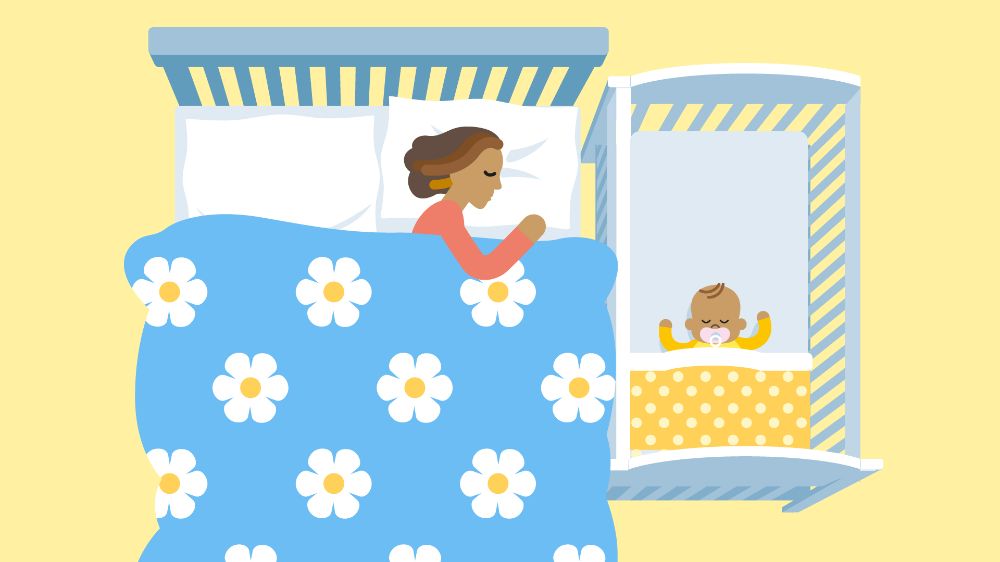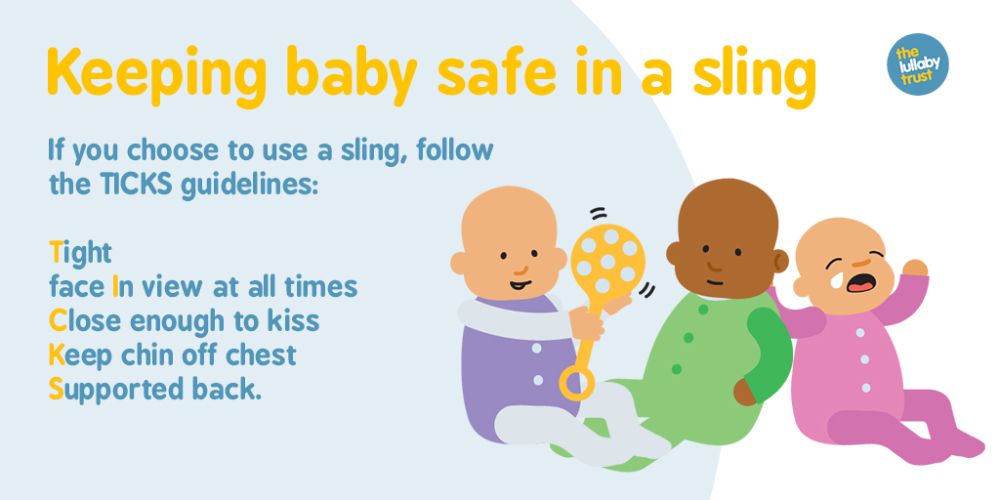Experts do know placing a baby to sleep on their back reduces the risk, and exposing a baby to cigarette smoke or allowing them to overheat increases the risk. It's also known there's an association between sleeping with your baby on a bed, sofa or chair (co-sleeping) and SIDS.
Follow the advice on this page to reduce the risks as much as possible.
How to reduce the risk of SIDS
To reduce the risk of SIDS:
· place your baby on their back to sleep, in a cot in the same room as you, for the first 6 months
· keep your baby's head uncovered – their blanket should be tucked in no higher than their shoulders
· if wearing your baby in a sling or carrier, do not cover their head with the sling material or with a muslin
· place your baby in the "feet to foot" position, with their feet at the end of the cot or moses basket
· do not let your baby get too hot or cold
· do not share a bed with your baby
· never sleep with your baby on a sofa or armchair
· do not smoke during pregnancy or breastfeeding, and do not let anyone smoke in the same room as your baby
Place your baby on their back to sleep
· Place your baby on their back to sleep from the very beginning for both day and night sleeps. This will reduce the risk of cot death.
· Do not put your baby to sleep on their side or tummy.
· Once your baby is old enough to roll over, there's no need to worry if they turn onto their tummy or side while sleeping
Do not let your baby's head become covered
Babies whose heads are covered with bedding are at an increased risk of SIDS.
To prevent your baby wriggling down under the covers, place them in the "feet to foot" position. This means their feet are at the end of the crib, cot or moses basket.
To put your baby in the feet to foot position:
· tuck the covers in securely under your baby's arms so they cannot slip over their head – use 1 or more layers of lightweight blankets
· use a baby mattress that's firm, flat, well-fitting, clean and waterproof on the outside – cover the mattress with a single sheet
· do not use duvets, quilts, baby nests, wedges, bedding rolls or pillows
If you use a sling or carrier, make sure you use it safely.
The Lullaby Trust has more information and advice about swaddling your baby and using slings. Please click here
Do not let your baby get too hot or too cold
Overheating can increase the risk of SIDS. Babies can overheat because of too much bedding or clothing, or because the room is too hot.
· When you check your baby, make sure they're not too hot. If your baby is sweating or their tummy feels hot to the touch, take off some of the bedding. Do not worry if their hands or feet feel cool – this is normal.
· It's easier to adjust for the temperature by using layers of lightweight blankets. Remember, a folded blanket counts as 2 blankets. Lightweight, well-fitting baby sleeping bags are a good choice, too.
· Babies do not need hot rooms. All-night heating is rarely necessary. Keep the room at a temperature that's comfortable – about 16 to 20C is ideal.
· If it's very warm, your baby may not need any bedclothes other than a sheet.
· Even in winter, most babies who are unwell or feverish do not need extra clothes.
· Babies should never sleep with a hot water bottle or electric blanket, next to a radiator, heater or fire, or in direct sunshine.
· Babies lose excess heat through their heads, so make sure their heads cannot be covered by bedclothes, slings or carriers while they're asleep.
· Remove hats and extra clothing as soon as you come indoors or enter a warm car, bus or train, even if it means waking your baby.
Do not share a bed with your baby
The safest place for your baby to sleep for the first 6 months is in a cot in the same room as you.
It's especially important not to share a bed with your baby if you or your partner:
· smoke (no matter where or when you smoke and even if you never smoke in bed)
· have recently drunk alcohol
· have taken medicine or drugs that make you sleep more heavily
The risks of co-sleeping are also increased if your baby:
· was premature (born before 37 weeks), or
· had a low birthweight (less than 2.5kg or 5.5lb)
As well as a higher risk of SIDS, there's also a risk you might roll over in your sleep and suffocate your baby.
Your baby could also get caught between the wall and the bed, or roll out of an adult bed and be injured.
Never sleep with a baby on a sofa or armchair
It's lovely to have your baby with you for a cuddle or a feed, but sleeping with your baby on a sofa or armchair is linked to a higher risk of SIDS.
It's safest to put your baby back in their cot before you go to sleep.
Do not let anyone smoke near your baby
Babies exposed to cigarette smoke before and after birth are at an increased risk of SIDS. Do not let anyone smoke in the house, including visitors.
Ask anyone who needs to smoke to go outside. Do not take your baby into smoky places.
If you smoke, sharing a bed with your baby increases the risk of cot death.
Get help and support if you want to quit smoking. Please click here
Feeding, dummies and SIDS
Breastfeeding your baby reduces the risk of SIDS.
It's possible using a dummy at the start of a sleep also reduces the risk of SIDS. But the evidence is not strong and not all experts agree that dummies should be promoted.
If you do use a dummy, do not start until breastfeeding is well established. This is usually when your baby is around 1 month old.
Stop giving them the dummy when they're between 6 and 12 months old.
Get medical help quickly if your baby is unwell
Babies often have minor illnesses that you do not need to worry about.
Give your baby plenty of fluids to drink and do not let them get too hot. If your baby sleeps a lot, wake them up regularly for a drink.
It can be difficult to judge whether an illness is more serious and needs urgent medical attention.
See spotting the signs of serious illness for guidance on when to get help. Please click here







